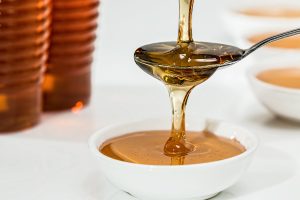
Honey is one of the most versatile and nutritional natural products found in nature. It has been used in food and medicine around the world since ancient times. From its use in traditional healing remedies to its sweetness in baking, honey has become a beloved staple of diets worldwide. But what makes honey so beneficial to our health and what makes it so special?
Honey is a sweet, thick liquid made by honeybees when they collect nectar and pollen from flowers. It is produced in the bee’s stomach and then stored in the honeycomb until it is ready to be harvested. The composition of honey is incredibly complex and includes over 180 different compounds, such as minerals, enzymes, vitamins, amino acids and antioxidants.
Benefits of Honey
Despite its sweetness, honey has many potential health benefits that make it worth seeking out.
First, honey has a high concentration of antioxidants, which are compounds that help fight free radicals in the body. Free radicals can cause damage to cells, leading to a variety of health problems such as cancer and heart disease. Eating foods with antioxidants helps to reduce the risk of these diseases. Honey contains a wide variety of antioxidants, including flavonoids and phenolic acids. These antioxidants are thought to help protect against disease and premature aging.
Second, honey is a good source of energy. The simple sugars in honey are quickly absorbed and used by the body for energy. This means that honey can be used to boost energy levels during exercise, or to help with recovery after exercise. Honey is also a great way to satisfy a sweet tooth without the added sugar of other sweeteners.
Third, honey is thought to help promote good digestive health. Honey contains a number of beneficial bacteria, which are thought to help support a healthy gastrointestinal tract. These bacteria may help prevent constipation, diarrhea, and other digestive issues. Additionally, honey has been found to help reduce symptoms of irritable bowel syndrome.
Fourth, honey has anti-inflammatory properties. Inflammation is a natural response of the body to injury or infection, but chronic inflammation can lead to serious health problems. Studies have found that honey can help reduce inflammation, which can help treat and prevent a variety of conditions.
Fifth, honey can help with wound healing. It has antibacterial and antifungal properties, which can help protect against infection. Additionally, honey has been found to help reduce pain and promote tissue regeneration. Applying honey directly to a wound can help speed up the healing process.
Honey can also aid in weight loss. Since honey is sweeter than sugar, you can use less of it to sweeten foods and drinks. This can help reduce overall calorie intake, which can lead to weight loss. Additionally, honey can help boost metabolism and reduce appetite, which can also help with weight loss.
History of Honey
The first use of honey can be traced back to the Stone Age, when ancient humans used it as a sweetener in food and drinks. It was also used as a medicine and a preservative. Honey has been found in the tombs of Egyptian Pharaohs, and it was used in their religious rituals and ceremonies. The ancient Greeks and Romans used honey extensively in cooking and baking, and it was also used as a primary sweetener in many of their beverages.
In 6th century BCE, ancient Chinese scholars used honey as a medicine and a beauty aid. They believed it had healing properties and could cure a variety of illnesses. In the same time period, the ancient Greeks used honey as part of their religious ceremonies. They would make offerings of honey to their gods and use it to ward off evil spirits.
In the Middle Ages, beeswax and honey were considered valuable commodities, and honey was used as a sweetener in many dishes. In the 15th century, it was used to treat wounds and to make mead, a popular beverage of the time. Honey was also used to make candles, as well as for medicinal purposes.
In the 18th century, French beekeeping was in its heyday. French beekeepers developed the first commercial beekeeping operations and honey became a highly sought-after commodity. At this time, honey was primarily used in the form of mead, a popular alcoholic beverage. It was also used to make jams, jellies and other desserts.
In the 19th century, beekeeping expanded to the United States. As beekeepers gained access to new regions, they were able to produce different types of honey. Popular varieties of the time included clover, orange blossom and buckwheat honey.
In the 20th century, the demand for honey increased as people began to appreciate its health benefits. Today, honey is used in a variety of dishes and drinks, as well as in cosmetics and health treatments. It is available in many different varieties, such as manuka, wildflower, tupelo and acacia honey.
Through the centuries, honey has been a valuable commodity and has been used for culinary, medicinal and ceremonial purposes. Its popularity continues to grow today, as people recognize its health benefits and discover new ways to use it. Honey has been a part of human life for centuries, and it will continue to provide us with its sweet flavor and health benefits for years to come.

Cooking with Honey
Cooking with honey is a delicious and healthy way to add a little sweetness to your dishes. Honey is an ancient ingredient that has been used for centuries in many different recipes, from sweet desserts to savory dishes. In addition to its unique flavor, honey is also packed with beneficial vitamins and minerals, making it an excellent addition to any meal.
Honey is incredibly versatile and can be used in a variety of recipes. In desserts, it can be used as a sweetener, an ingredient in syrup, or as a topping on cakes and muffins. It can also be used as an ingredient in savory dishes, such as glazes and marinades.
When cooking with honey, it’s important to choose the right variety. Depending on the recipe, you may want to select a lighter or darker color honey, as the flavor will be more pronounced in the darker varieties. Additionally, it’s important to consider the type of honey you are using. Some are more viscous and better suited for glazes and syrups, while others are better for baking.
When baking with honey, it’s important to adjust the other ingredients in the recipe. Since honey is sweeter than sugar, you will need to reduce the amount of sugar in the recipe. Additionally, you may need to increase the amount of liquid, as honey is more hygroscopic than sugar. This means that it will absorb more liquid from the recipe, resulting in a moister end product.
When cooking with honey, it’s important to keep in mind that it can burn easily. You should always keep the heat low and stir the mixture frequently to avoid burning. Additionally, it’s important to watch the temperature carefully, as too much heat can cause the honey to caramelize, giving it a burnt taste.
Clinical Trials on Honey
The medicinal use of honey dates back to ancient Egypt, where it was used to treat wounds and infections. In the modern era, clinical studies have been conducted to evaluate the efficacy of honey in treating various health conditions.
One of the first studies to evaluate the efficacy of honey in treating wounds was conducted in 2003. The researchers found that honey was more effective than conventional wound dressings in healing wounds faster and reducing the risk of infection. The study concluded that honey was an effective and safe treatment for wounds.
Another study conducted in 2006 examined the effects of honey on the symptoms of upper respiratory tract infections. The study found that honey was more effective than conventional medicines in reducing the symptoms of cough, sore throat, and runny nose. The study concluded that honey was effective and safe for treatment of upper respiratory tract infections.
Clinical trials have also been conducted to evaluate the use of honey in treating digestive ailments. One study conducted in 2007 found that honey was effective in reducing the symptoms of irritable bowel syndrome, such as abdominal pain, bloating, and constipation. The study concluded that honey was an effective and safe treatment for irritable bowel syndrome.
Studies have also been conducted to evaluate the effects of honey on diabetes. One study conducted in 2009 found that honey was effective in reducing blood glucose levels in diabetic patients. The study concluded that honey was an effective and safe treatment for diabetes.
Clinical trials have also been conducted to evaluate the effects of honey on skin conditions. One study conducted in 2014 found that honey was effective in reducing the symptoms of eczema, such as itching and redness. The study concluded that honey was an effective and safe treatment for eczema.